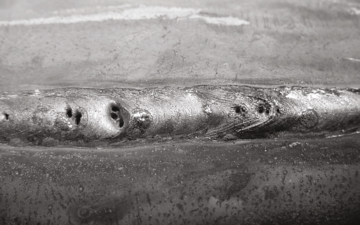Understanding Porosity in Welding: Exploring Causes, Results, and Avoidance Methods
Porosity in welding is a consistent difficulty that can considerably impact the top quality and stability of welds. As professionals in the welding market are aware, recognizing the reasons, effects, and prevention methods associated with porosity is vital for accomplishing durable and trustworthy welds. By diving right into the origin causes of porosity, examining its detrimental impacts on weld high quality, and discovering reliable prevention approaches, welders can improve their understanding and abilities to generate high-grade welds consistently. The detailed interaction of elements adding to porosity needs a comprehensive understanding and an aggressive strategy to make certain successful welding end results.
Typical Sources Of Porosity
Contamination, in the type of dust, oil, or corrosion on the welding surface, develops gas pockets when heated, leading to porosity in the weld. Inappropriate securing takes place when the securing gas, commonly used in procedures like MIG and TIG welding, is unable to totally shield the liquified weld pool from reacting with the surrounding air, resulting in gas entrapment and subsequent porosity. In addition, poor gas protection, commonly due to inaccurate circulation prices or nozzle positioning, can leave parts of the weld unprotected, permitting porosity to form.
Impacts on Weld High Quality
The visibility of porosity in a weld can considerably endanger the general top quality and honesty of the bonded joint. Porosity within a weld produces spaces or cavities that deteriorate the structure, making it extra at risk to breaking, corrosion, and mechanical failing. These spaces serve as stress concentrators, minimizing the load-bearing capability of the weld and increasing the likelihood of premature failure under used tension. Additionally, porosity can additionally function as potential sites for hydrogen entrapment, further aggravating the degradation of the weld's mechanical residential properties.
In addition, porosity can hinder the efficiency of non-destructive testing (NDT) techniques, making it testing to find various other problems or gaps within the weld. This can bring about considerable safety concerns, particularly in essential applications where the architectural integrity of the welded parts is extremely important.

Avoidance Techniques Introduction
Provided the damaging impact of porosity on weld top quality, efficient prevention methods are essential to preserving the structural stability of welded joints. One of the key prevention methods is complete cleaning of the base products before welding. Pollutants such as oil, oil, rust, and moisture can contribute to porosity, so guaranteeing a clean work surface is vital. Correct storage of welding consumables in completely dry conditions is also vital to avoid dampness absorption, which can lead to gas entrapment blog here throughout welding. Additionally, picking the ideal welding specifications, such as voltage, current, and take a trip speed, can assist lessen the threat of porosity development. Making sure appropriate protecting gas flow and insurance coverage is an additional crucial prevention strategy, as not enough gas insurance coverage can lead to climatic contamination and porosity. Lastly, appropriate welder training and accreditation are important for executing safety nets properly and regularly. By incorporating these avoidance methods right into welding methods, the occurrence of porosity can be substantially lowered, resulting in stronger and extra reputable bonded joints.
Relevance of Correct Protecting
Proper protecting in welding plays a critical duty in protecting against climatic contamination and making sure the stability of welded joints. Shielding gases, such as argon, helium, or a mixture of both, are typically utilized to shield the weld pool from responding with components airborne like oxygen and nitrogen. When these responsive aspects enter into contact with the hot weld pool, they can trigger porosity, resulting in weak welds with minimized mechanical properties.

Inadequate securing can lead to various problems like porosity, spatter, and oxidation, jeopardizing the structural integrity of the welded joint. For that reason, sticking to appropriate securing techniques is vital to create top quality welds with minimal defects and ensure the durability and dependability of the bonded elements (What is Porosity).
Monitoring and Control Methods
Just how can welders click for info effectively keep an eye on and regulate the welding process to guarantee optimum results and stop problems like porosity? By continually keeping an eye on these variables, welders can identify deviations from the optimal problems and make prompt changes to protect against porosity formation.

Furthermore, executing proper training programs for welders is essential for keeping an eye on and managing the welding process effectively. What is Porosity. Enlightening welders on the value of keeping consistent parameters, such as appropriate gas navigate to these guys shielding and take a trip speed, can help prevent porosity concerns. Normal assessments and accreditations can also guarantee that welders excel in monitoring and regulating welding procedures
Additionally, using automated welding systems can boost surveillance and control capacities. These systems can exactly regulate welding criteria, reducing the possibility of human mistake and making sure regular weld quality. By integrating innovative surveillance innovations, training programs, and automated systems, welders can successfully keep track of and manage the welding process to minimize porosity problems and accomplish high-grade welds.
Verdict
